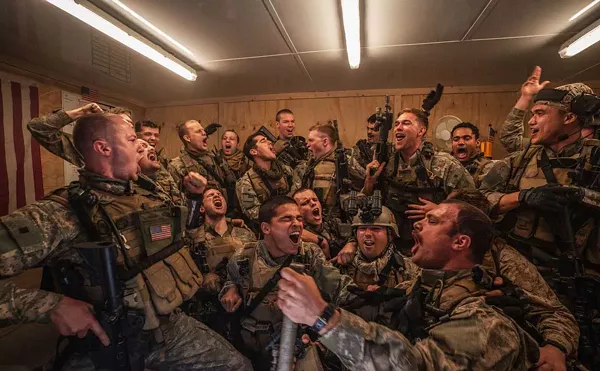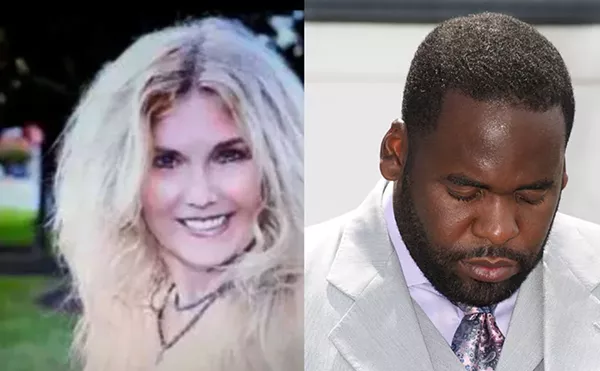
Audio By Carbonatix
[
{
"name": "GPT - Leaderboard - Inline - Content",
"component": "35519556",
"insertPoint": "5th",
"startingPoint": "3",
"requiredCountToDisplay": "3",
"maxInsertions": 100,
"adList": [
{
"adPreset": "LeaderboardInline"
}
]
}
]
Ever since he was 12 years old, veteran photographer Ed “Robbie” Roberson has been collecting the souls of black folk. Some might view Roberson’s photographs and see merely pictures, but those individuals aren’t paying attention. What this man has somehow miraculously managed to capture is the soul and spirit of a people. His people.
These are not just pictures.
Today, nearly 70 years after Roberson first picked up a camera and began his life’s passion, his amazingly extensive collection of photographs that chronicles the existence of African-American people — many of them Detroiters — over more than half of the 20th century can be seen at the Detroit Public Library as part of Detroit Focus 2000. To miss this exhibit would be to commit a crime.
Perhaps the most amazing thing about Roberson’s collection is how one lone individual could manage to be in so many places at one time, let alone so many perfect places at all the right times to get so many perfect photographs. The swearing in of Coleman Young as mayor of Detroit. The Detroit riots. The funeral of President John F. Kennedy. The three major civil rights marches led by Dr. Martin Luther King — and then his funeral. Malcolm X speaking before a crowd somewhere in Detroit. Stevie Wonder’s first wedding. Marvin Gaye’s first wedding. The Temptations before they were the Temptations. Prophet Jones in life and in death. Emmett Till, who was lynched in Mississippi when he was just a boy for the “sin” of whistling at a white woman.
It was the shot of Emmett Till, taken when Roberson was just 12 years old, that launched his career as a professional photographer. The photo, which was taken using a camera Roberson had purchased in a pawn shop, ran in Jet magazine and was also picked up by the National News Agency. From that point forward, Roberson knew in his heart that he had to chronicle the events of the civil rights movement. His pictures have appeared in numerous publications over the years, including the Michigan Chronicle.
When asked how it was possible to be in so many right places at the right time, Roberson shrugs his shoulders. He is walking slowly through his house on Linwood Avenue, past random stacks of photographs and other memorabilia that, for whatever reason, weren’t chosen for the current ongoing exhibit.
“You don’t know how these things happen,” he says.
One thing he does know, however, is that he always paid his own way wherever he went. Unlike those staff photographers who perhaps worked for a major daily newspaper or a large magazine, Roberson has nearly always preferred to be more in control of his career and his work, plus he has shot the majority of his work for black publications. While this has been good in terms of retaining control, it has also meant a considerable amount of sacrifice, and a level of pay that most often was far below what his peers were earning and far below what his material was worth. And while others had access to some of the better, more up-to-date photographic equipment, Roberson routinely got the job done with the several not-quite-up-to-date cameras that he routinely carried with him around his neck whenever he was on assignment.
In talking with Roberson, one gets the feeling that he’s one of those special people whose life’s work chose him, not the other way around. The same could be said of many of those whom he has photographed over the years, such as Malcolm X and Dr. Martin Luther King. It could be debated forever whether it’s true that many are called and few are chosen, but if many are called and few bother to answer, then Roberson can definitely be counted among those who were listening when the call came through. After more than six decades of taking pictures, he has essentially become that which he has committed himself to. The souls in Roberson’s collection have been absorbed into his persona, and he carries them around wherever he goes as if he were some sort of spiritual repository.
The two-story white house on Linwood, which is somewhat rundown and in need of repair, gives no evidence from the outside of all the treasure contained within. Inside, where it’s noticeably cooler than outdoors, it’s not readily apparent that there’s anything particularly special about the location until Roberson takes care to point proudly to a photograph here, or the other one over there, or still another one lying on a table in the room in the back surrounded by still more photos scattered about. He rarely finishes explaining about one photograph before he’s on to the next one, interspersing bits and pieces of historical anecdotes that he has lived through and seen with his own eyes — and the eye of his camera.
“So what do you think?” he asks often, wearing a slight smile as he examines my face intently to see whether there’s any true understanding of what is displayed here, or whether this is just another head-nodding type who doesn’t really have a clue.
When I tell him that I honestly don’t have the words to give adequate praise, he continues to smile and nods. Rarely does he talk in much detail about the circumstances surrounding any specific photograph, other than to point out who some of the people are or where it was shot. When he comes to a photo of Dr. Martin Luther King’s tomb, however, it is clear how much the painful memory of the funeral sticks with him to this day.
“I slept out there at Dr. King’s grave for two days,” he says.
When asked why, Roberson explains that all the people one would expect to show up at King’s funeral would be there during the formal event — meaning that such an event would provide important photos, but photos that just about every other photographer there would take as well. By staying on-site for two days, Roberson was also able to photograph those who, for whatever reason, couldn’t legitimately attend the larger funeral and had to come at, well, less conspicuous times.
There are pictures mounted on boards, pictures framed in glass, pictures stacked on top of other pictures and pictures stuffed in envelopes in virtually every corner of every room both upstairs and downstairs. Some of them have tumbled to the floor. Some are in relatively good shape, while others are beginning to show the effects of time, but they’re all remarkable. It’s no exaggeration to say that there are few — if any — bad pictures to be seen, no matter what the condition. That would explain the numerous commendations and awards that Roberson has received over the years and that are displayed throughout the house.
A couple of times Roberson seemed close to tears as he contemplated all that he had done and seen during his life, gesturing with one sweeping motion of his arm indicating all that’s contained within the confines of such a modest house.
“The story of my life, man,” he says, his voice starting to catch in his throat — but only for a moment. Moments later, he points with a smile at a tiny wooden chair that sits off to the side of the stairs.
“That’s my baby chair.”
There is also the first camera he ever owned, looking almost as if it could still be used today. Elsewhere throughout the downstairs front room are a number of ancient cameras of varying sizes and shapes that he has used over the years. Next door, located in the basement, is Roberson’s home photo lab where he has accumulated just about everything he needs to produce his own photographs while having to rely on hardly anyone else.
“I don’t show this to very many people,” he says.
In his backyard, Roberson proudly displays his collection of old cars which he hopes to be able to fix up one day. A long, dark limousine is his obvious favorite as he opens the door, points inside to the once-plush interior and begins to describe all the luxury features as if they were still in evidence. After pointing to some of the others and discussing their merits as well, Roberson decides the tour is over.
“I guess I’ll let you go now,” he says. “And don’t tell them about the bitterness.”
After all, the only thing Roberson ever really wanted to accomplish with his photographs was to achieve an appreciation for the numerous accomplishments of black people.
“I wanted to show black people doing something, man.”
And that he has done.
Keith A. Owens is a Detroit writer, editor and musician. E-mail letters@metrotimes.com




